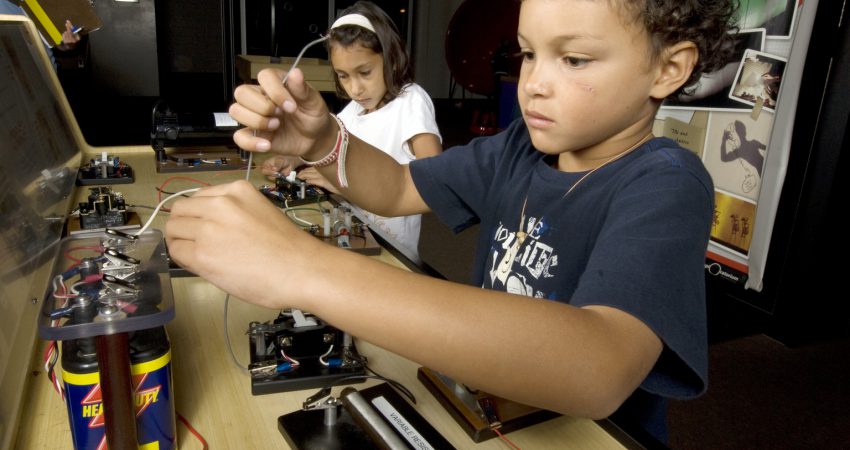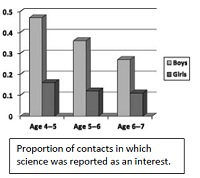
By Melissa Ballard - March 2014
PAPER CITATION
Alexander, J. M., Johnson, K. E., & Kelley, K. (2012). Longitudinal analysis of the relations between opportunities to learn about science and the development of interests related to science. Science Education, 96(5), 763–786. doi:10.1002/sce.21018
This study considers the link between preschoolers’ early exposure to informal science experiences and their interest in science. Through a longitudinal study of children aged 4 to 7, the researchers sought to understand whether parent-created opportunities sparked children’s interest or if children’s interest drove parents’ choice to provide science learning opportunities. The informal science learning opportunities considered in this study included activities both at home and in the community, such as playing with science-related toys, consuming electronic media, reading books, conducting experiments, and visiting museums.
Previous research has shown that boys are more likely than girls to experience science learning opportunities. Furthermore, boys are more likely to have certain types of experiences; for example, they are more likely to have engaged with physical science while girls are more likely to have engaged with the life sciences. Hence, the researchers paid particular attention to gender differences in their analysis.
Theoretical Basis
The authors define interest as both a psychological state and an individual predisposition. The authors believe that well-developed interests shape whether and how children choose to engage with related topics in the future. Children often display interest in a class of objects, such as dinosaurs, and engage in a variety of related activities: reading books, playing with toy dinosaurs, or going to a science center exhibit on dinosaurs. The authors have found little research on how and why early interests emerge and are sustained. They posit a coregulation model in which children’s interest and parents’ effort to provide learning opportunities synergistically drive each other.
Research Design
Participants took part in a larger study on interest development in children, in which only a subset of the analyses was directed specifically at science interests. The 215 participating families were mostly white (86%), with smaller percentages of black (6%) and Latino (3%) children. Families were primarily middle class, with an average education level of 16 years for both parents. The majority of families were recruited through an urban university campus and the rest through a rural university site.
Children began the study at age 4 and continued through age 7. Researchers examined two measures:
- Frequency of family activities related to science
- Parents responded to a questionnaire during three yearly laboratory visits.
- In the final year, parents completed a more detailed questionnaire, the Community and Home Activities Related to Science/Preschool (CHARS/PS, see Korpan et al., 1997).
Children’s interest in science
- Parents were interviewed 15 times during the study, by phone or email, about how their children preferred to spend free time and whether they showed focused interest in any topics or kind of activity.
- Answers were designated as science or non-science and coded as one of the content areas of the CHARS/PS.
The authors used path analysis to test the hypothesized coregulation relationship between science learning opportunities and parent-reported science interests. Path analysis is a statistical procedure that finds the relationships among variables across time.
Research Findings

- Early science interest was a strong predictor of later parent-provided informal science opportunities. Parents of both boys and girls responded to demonstrated science interest by offering more opportunities the following year.
- Providing early opportunities did not predict later science interests. The authors note that this finding runs counter to many middle-class families’ belief that providing early science learning opportunities will spark, maintain or increase interest.
- The best predictor of a child’s later interest in science, during ages 4–7, was an earlier interest.
- Science interest for both genders declined from age 4 to age 7. This decline was more dramatic for boys, but boys’ interest levels were persistently higher than girls’ interest.
- Boys and girls scored about the same in science learning opportunities. However, parents did not provide the same types of science activities to boys and to girls with equal frequency.
Implications for Practice
Informal science education (ISE) is often cited as being able to improve interest and engagement in science for school-aged children. ISE practitioners thus want to understand how children’s science interest develops over time, how it persists, how it interacts with future educational and career choices, and how the field can best support that interest. This study demonstrates that young children do demonstrate a genuine interest in science and will engage in science learning when given the opportunity.
Further research is required to better understand why young children’s interest in science drops across ages 4 to 7 as well as the causes of stark gender differences in science interest. The authors note that many studies have identified reasons that science interest changes for school-aged children, particularly as to how it affects classroom behaviors and future educational choices. As we learn more about the dynamics early in a child’s life, we will be better able to determine how the ISE field can best support lifelong science education.
ISE institutions like science centers and museums primarily serve families, which often include young children. The families in this study consistently sought learning opportunities outside the home, like those provided by ISE institutions. ISE institutions are therefore well-situated to serve as educational and pedagogical resources to parents of young children. ISE practitioners can help parents recognize burgeoning science interest in their children and provide programming to support meaningful development.
The study participants were demographically similar. Different results may be found with other economic or racial and ethnic groups. The authors suggest that science may have been omnipresent in the middle-class homes studied—science interest was high at the start of the study and retrospective reports from parents confirm that children’s interest developed early on. Due to the scope of the study, conclusions cannot be drawn about the relationship between early opportunities and later interest prior to age 4.
References
Korpan, C. A., Bisanz, G. L., Bisanz, J., & Lynch, M. A. (1997). What did you learn outside of school today? Using structured interviews to document home and community activities related to science and technology. Science Education, 81(6), 651–662.




